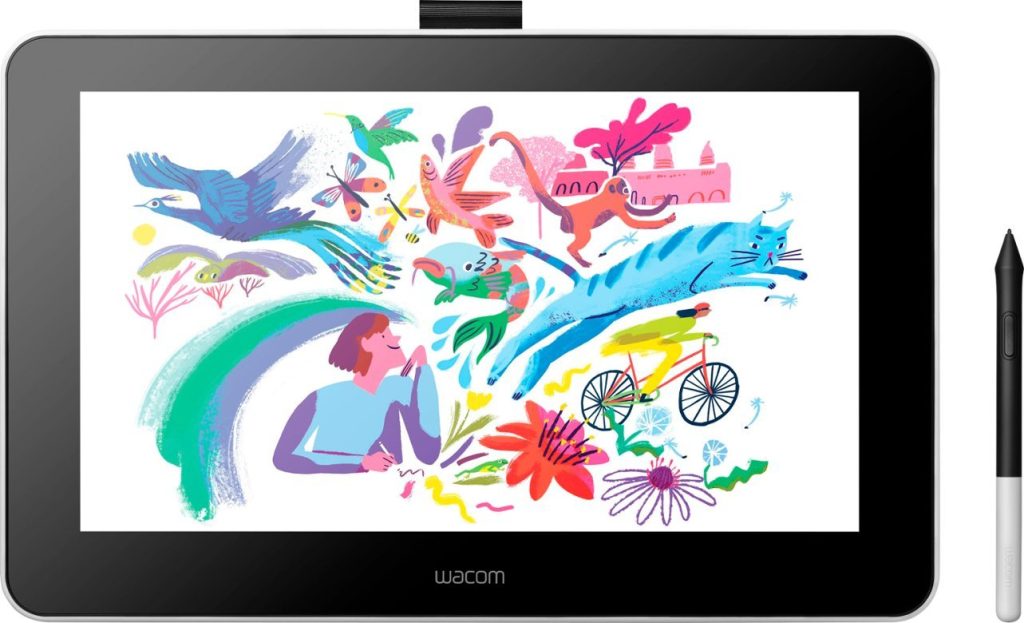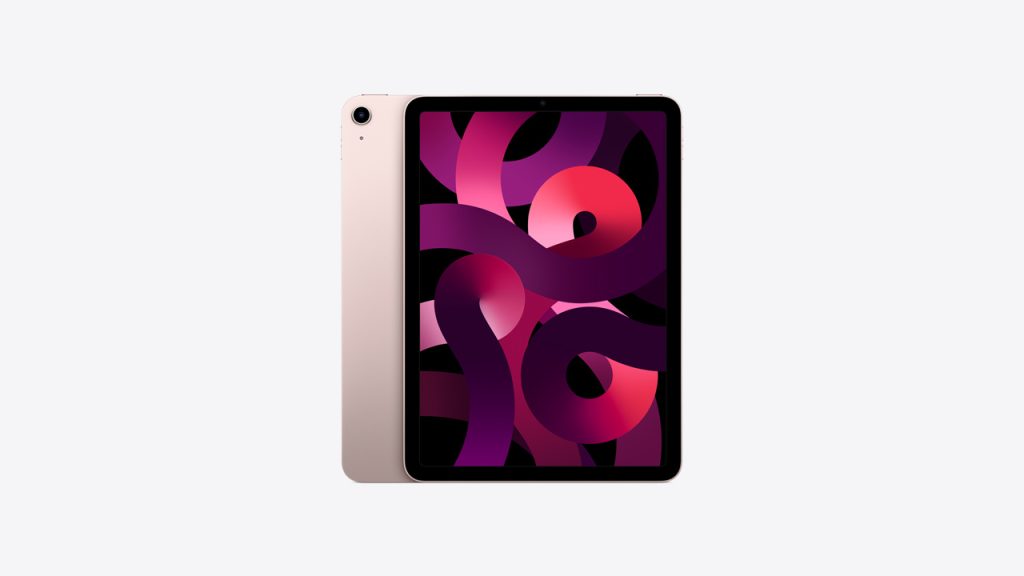Ready to take your art journey to the next level? Digital art is a great way to stretch those artist muscles and experiment with all kinds of mediums!
Before you brainstorm your big ideas, however, you’ll need to find the best drawing tablet to get you started.
What Is a Drawing Tablet?
If you are scratching your head about what exactly a drawing tablet is, you are not alone. The marketing around drawing tablets, graphic tablets, and pen displays is murky.
For now, all you need to know is that “drawing tablet” is an umbrella term for pieces of tech that convert your drawings, doodles, and handwriting into digital art. To dive a little deeper, we have to talk about pen tablets vs. pen displays.
Pen tablets must be connected to a computer, monitor, or laptop. This kind of drawing tablet has no screen. The surface acts as a trackpad for your stylus, and your cursor mirrors the stylus on your monitor or laptop.
On the other hand, display tablets have built-in screens. You still use a stylus to draw on the tablet, and you can see your input on the built-in screen and your monitor.
Which Drawing Tablet Is Better for Beginners?
The consensus is that display tablets are better for beginners. New digital artists experience less of a learning curve since they are drawing directly onto their image.
Pen tablets and displays are two of the best drawing accessories for iPad users. But, to give your digital art dreams the best start possible, we are focusing on display tablets. Let’s look at our top 3 best drawing tablets for beginners.
Wacom One (2019)

Price: $300
Specifications
- Size: 13.3 inches
- Screen: 11.6 x 6.5 inches
- Resolution: 1920 x 1080 (Full HD)
- Response time: 26ms
- Weight: 2.2 lbs
When we talk about art tablets for beginners, we immediately think about Wacom. Wacom is a well-known brand in the digital art community, and for good reason. It creates reasonably priced tablets that have all the features a beginner could ask for.
Wacom One is our top pick for people who are new to the digital art world. The screen is about the size of a piece of paper, making the transition as easy as possible. It is also free from buttons, which some beginners might find overwhelming.
The built-in legs are a nice touch, but they don’t lift very high. On top of that, Wacom One is an external display, so you need to plug it into another device to activate the screen. The cables can be frustrating, but this is partially mitigated by the fact that the tablet can connect to smartphones as well as monitors.
Before you hit buy, be careful. Wacom One is often confused with One by Wacom, which is a screenless tablet.
Pros
- Stylus included. The super thin, intuitive stylus is included, so you don’t have to pay extra!
- On-screen shortcuts. Create personalized on-screen shortcuts to streamline your workflow.
- Compatibility. This tablet works with Windows, Mac, and Android devices.
- Built-in legs. Two legs allow you to adjust the position of your tablet, greatly reducing wrist strain.
Cons
- No express keys. Once you get the hang of using a drawing tablet, you might wish it had shortcut keys.
- Cables. The cables can be frustrating, especially for people who want to work in cafes and other shared spaces.
- Not compatible with IOS or iPadOS. If you’re looking to connect a Wacom to an iPhone or iPad, unfortunately, Wacom One is not compatible.
iPad Air (5th Gen, 2022)

Price: $549 – $849
Specifications
- Dimensions: 9.74 x 7.02 x 0.24 inches
- Screen: 10.9-inch
- Resolution: 2350 x 1640
- Response time: 34.3ms
- Weight: 1.02 lbs
Of course, Apple has made it onto our list of the best drawing tablets for beginners. The jury is out on whether an iPad can be put in the same category as more traditional drawing tablets but regardless, iPads are extremely effective, versatile, and efficient.
We’ve chosen the iPad Air because it has similar features to the iPad Pro, but it is slightly less expensive. The iPad Air has the same M1 chip that is found in the iPad Pro, so you benefit from a laptop-class processor. The 8-core CPU delivers up to 60% faster performance than the previous generation, supporting a seamless drawing experience.
To get the most out of your new tablet, you need to purchase an Apple Pencil. The Apple Pencil has been hailed as the best drawing stylus on the market. The low-latency, pixel-perfect technology is great for precise, intuitive workflows.
The screen-to-body ratio is 81.3%, which is pretty good, but it also means that you don’t get 10.9 inches of uninterrupted drawing space. This is the trade-off for every digital art app imaginable. Procreate, Illustrator, and Fresco are all available (in albeit limited forms) on iPads.
If you’re looking for a Wacom-like drawing experience, Astropad Studio allows you to mirror your Mac or PC onto your iPad, giving you access to full-scale desktop creative programs. Or you can transform your iPad into a no-screen pen tablet with Astropad Slate, allowing you to use your iPad as trackpad and input device for Mac.
The biggest benefit of choosing an iPad for art is that it has lots of other functions. You can enjoy endless entertainment options, research your latest creations, and even Facetime your friends. The iPad Air is expensive, but if you use it for multiple purposes, the price starts to make sense.
Pros
- Lighter than other iPads. The iPad Air is almost half a pound lighter than the iPad Pro!
- Wide range of digital art apps. Every digital art tool imaginable is at your fingertips.
- Multi-use. Watch Netflix, surf the web, and take notes in between drawing sessions.
- No cables. You can use your iPad as an all-in-one drawing tablet without getting tangled in cables.
Cons
- Stylus not included. Apple Pencil styluses might be effective, but they are not cheap. The 1st gen version is $99, and the 2nd gen pen is $129.
- High price point. It is no surprise that iPads are the priciest art tablets for beginners.
- Limited storage options. 64GB and 256GB might be enough storage for some, but other tablets offer better variety.
XP-Pen Artist 12 (Gen 2)

Price: $199.99
Specifications
- Dimensions: 14.3 x 8.6 x 0.4 inches
- Screen: 11.6-inch
- Resolution: 1920 x 1080
- Response time: 14ms
- Weight: 1.9 lbs
The XP-Pen Artist 12 is a certified favorite among beginners.
Artist 12 has a fully laminated screen, which is a nice upgrade from its sister models. The matte finish reduces glare, allowing you to focus on your artwork. The display guarantees 127% sRGB color accuracy, creating super clear images. It is ideal for anyone who wants to print their creations.
Eight express keys allow you to customize shortcuts and streamline your workflow, which is a big plus point for serious digital artists.
On top of that, the stylus is intuitive and easy to use. The slim, natural feel is akin to holding a pen, and it has a simple rocker-style button that you can customize. It has 8192 levels of pressure sensitivity, a 10mm reading height, and can support up to 60° tilt.
At almost 2 lbs, this drawing tablet is lighter than the Wacom One but heavier than the iPad Air. It has a solid, premium feel. The stylus holder makes it easy to transport everything with you on your travels.
Pros
- Color options. Artist 12 is available in Black, Green, Blue, and Pink.
- All-in-one cable. The 3-in-1 cable supports HDMI signal transmission, allowing you to easily connect to Windows, Mac OS, or Android devices.
- Battery-free stylus. The stylus doesn’t need to be recharged, so you have one less thing to think about.
Cons
- Wobbly lines. Some users report that the XP-Pen produces wobbly lines after a few months of use.
- No toggle/touch button. The Artist 12 Pro has a red toggle button that allows you to zoom in and out, scroll up and down, and so on.
Final Thoughts
An artist is only as good as their tools, but that doesn’t mean you have to buy the most expensive art tablets to get started. In fact, we encourage beginners to try more affordable options before they commit to an expensive purchase.
If you already have an iPad, you can save a lot of money by getting a few drawing apps and an Apple Pencil instead of a whole new tablet. But if you’re starting from zero and evaluating all your options, a dedicated drawing tablet like Wacom or XP-Pen may be a better fit if you don’t see yourself using an iPad for other use cases outside of drawing.
Ultimately, it is all down to you. Which tablet has caught your eye?
Transform Your iPad into a Pen Tablet with Astropad Slate

Astropad Slate transforms your iPad into a no-screen drawing tablet, allowing you to use your iPad as an input device for Mac.
Your Mac cursor mirrors your Apple Pencil, meaning you can write and draw inputs that seamlessly translate to your Mac screen.
- Draw on your favorite desktop programs with your Apple Pencil stylus
- Write into the handwriting input box, and the text will appear on your Mac
- Use one and two-finger touch gestures on your iPad to scroll and zoom on your Mac




